#japanese society
Text
I think a lot of Buddy Daddies fans will be interested in this article by Unseen Japan entitled: How discriminatory comments by Japanese Prime Minister Kishida Fumio's secretary may lead to actual reform on LGBTQ+ issues in Japan.
Here is an excerpt from the article (with text provided underneath):

Text: Just days after Prime Minister Kishida minced words on legalizing same-sex marriage, his secretary Arai Masayoshi made things worse. Speaking to reporters off the record, Arai expressed his distaste for sexual minorities, saying, “I don’t want them living next to me either. ”Arai’s comments very much made it on the record. The ensuing backlash led to Kishida summarily sacking him. Arai’s blatant discrimination prompted politicians and activists to decry his comments and reignited discussions on the government’s failure to protect sexual minorities.
(Bold done by me for emphasis and to highlight what Arai said, specifically.)
There are also a lot of quotes by politicians in the article as well. One, Koizumi Shinjiro, makes this comment:

Text: Looking at the news reports on these statements, once again I feel that the government’s efforts to tackle the declining birth rate on a different dimension will never come to fruition if their policy is based on denying diverse values and ways of life [3].
It should be noted that many of the politicians, activists, and every day people in Japan do not agree with these sentiments and actually support same-sex marriage rights. Unseen Japan made a Twitter post about this, which I will link below.

Text: A new telephone poll by Kyodo News says that, in the wake of discriminatory comments against LGBTQ people by PM Kishida’s (former) secretary, a full 64% of people in Japan support same sex marriage rights. Only 24.9% oppose.
And the wild thing is that Buddy Daddies is airing right now, right when it seems like issues regarding same-sex marriage, discrimination, and general rights are all starting to reach a boiling point in Japan. We have this show airing about two hitmen living together and raising a child together. IN MODERN DAY 2023 JAPAN.
That’s the big thing. They aren’t raising a kid together in a made up fantasy land or in a sci-fi future world or in a city based off of NYC. Kazuki and Rei are raising Miri in modern day, 2023, Japan.
When Kazuki and Rei are at Miri’s daycare, listening to her speech with all the other parents (moms, really) like this:

They are going to be perceived as a same-sex couple. When the government official was looking over their paper work like this:
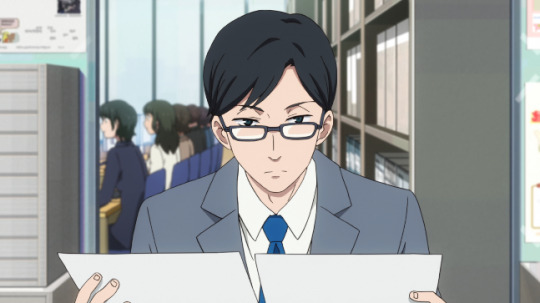
He was perceiving them as a same-sex couple.
We know that one of the theme’s of the series is “two people of the same sex raising a child together.” That was a modern day theme that they wanted to explore. And they are exploring it so mundanely. Like, there are some ridiculous aspects to the series, but those aspects aren’t connected to them being two guys raising a child. The ridiculous stuff usually stems from the conflicting aspects of their job and caring for Miri + their general personalities.
Instead, we are getting a story that is normalizing the concept of a same-sex couple (as society would perceive them) raising a kid together. Right when there is a shitstorm going on in the Japanese government around discriminatory statements about sexual minorities by the PM, the PM’s secretary, and other politicians in PM’s political party in the past (like back in 2018).
This is kinda revolutionary by not being revolutionary at all, and just presenting everything in a realistic and normal way (in regards to the more SOL aspects, anyway). And that, in the current Japanese social and political climate surrounding LGBT+ based issues, makes it a very queer series. Even if the creators weren’t intending on that.
And now, I am done finishing on this topic (at least for now), lol.
#Buddy Daddies#KazuRei#Kazuki Kurusu#Rei Suwa#same-sex marriage in Japan#Japanese government and politics#Japanese society#Japanese LGBT issues#LGBT#queer#queer media#long post#image heavy post
1K notes
·
View notes
Text
Why are most of the Japanese ghosts 'victimized women'? - the feminist answer to Japan's sexist society
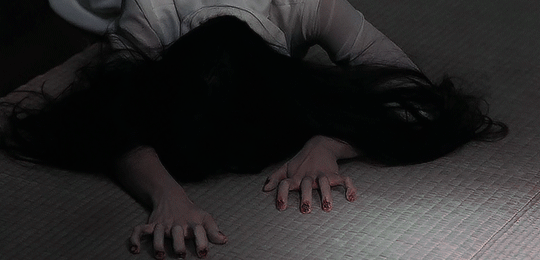
Let's talk a little about Japan and its horror culture. The "pale-dressed woman with black hair" ghost steriotype isn't an American invention, it came from the Japanese culture. This ghost is called Onryō (怨霊), a vengeful spirit that comes back from the dead to sick revenge against his/her killer or humanity itself. Onryō spirits mostly had violence deaths (murder, accident or suicide) and/or unfair lives. They are characterized as a pale person, with white clothes and a long, black hair. Some of the Onryō ghosts are marked with the violence they suffered before death. Male Onryōs can be found in the Japanese culture (cinema, mangas, animes, games and theatre), however, they are very rare and unusual, most of the Japanese ghosts are female. Female victims abused by men. After the iconic 2002 "The Ring", an American Remake of the Japanese best-seller Ringu, the Onryō image was introduced to the whole world.
Some of the most classic Japanese ghosts are: Oiwa, Okiku, Sadako Yamamura, Kayako Saeki, the Black Cat ghosts and Kuchisake-onna. All women. I will talk about them little by little and explain about their feminist essence. The Japanese culture was always male chauvinist and patriarchal, specially in the past. Women were treated as objects of male pleasure, they couldn't have any profission unless prostitution or cleaning/cooking. Men were the masters, women were the slaves. Many Japanese temples tought men that sexual activities with women was disgusting and exhausting, something that sucked vital energy. Sex with women should be ONLY for reproduction. It was a mysoginistic society, where the female body was faced as something vulgar and immoral. Women should mary as soon as possible (15-16 years old or less) or else they'll be called 'old whores'. Women couldn't even play in Kabuki shows (japanese traditional theatre) because it was considered immoral, the female roles were played by men. Rape, abuse (emotional and physical) and murder caused by men could be justified if their female victims were considered immoral women. Until today, women are oversexualized in Japanese culture specially if they are very young, hentais are a big example. There are Japanese companies that hire only men, there are victimized women that are still unheard and judged.
This male chauvinist opression has been answered for centuries with the legends of onryōs, curses and female revenge. The Japanese folklore and pop culture is full of feminists manifestations against the patriarchal society of Japan.
Oiwa (大岩)

This character appeared for the first time in the Kabuki best-seller show "Yotsuya Kaidan" (四谷怪談). She was a poor woman married to a greedy selfish man, Iemon. He was planning to marry a rich woman, but for this, he needed his wife to be all alone and defenseless, so he killed Oiwa's father. After that, he poisoned Oiwa with the intention of killing her, but she didn't die: her face melted and her hair felt. Iemon hired a man to rape his wife, then he could kill her with the excuse that she "cheated on him". However, the man was so disgusted with Oiwa's face that he couldn't rape her. Iemon, without any other choice, killed both Oiwa and the man he hired, throwing their bodies into the river. Iemon married a rich woman, but in his honeymoon, Oiwa's spirit came back from the dead and murdered both of them. The legend says she is still hauting her old village, and you get cursed by her spirit if you listen to her story (yes, I curses all of you😈😈).
Okiku (お菊元気)

The original story that inspired Koji Suzuki's Ringu series. Okiku was a poor employee that worked for a creepy rapey samurai named Aoyama Tessan. He wanted Okiku to be his lover, but she always denied it. One day, Aoyama planned to trap her: he gave her a closed bag with 9 coins, but he told her that there were 10 coins and that she should take care of them. Naïvely, Okiku took care of the bag for some days, until Aoyama came back and checked the coins. Again, there were always 9 coins, but he lied to her saying that there were 10, an employee couldn't doubt of her master's word so she never checked it before. Aoyama accused Okiku of stealing one of his coins. Desperate, she counted the coins: 1, 2, 3, 4, 5, 6, 7, 8, 9... over! No 10! Aoyama threatened Okiku, saying she could be spared if she agreed to be his lover. She denied for the last time. The samurai tortured the poor girl and throw her alive inside of a well. Okiku's ghost came back every single night to torment the samurai, forcing him to committ suicide. After Aoyama's death, a buddhist monk bought the land and freed Okiku's ghost after counting 'til 10, bringing her peace.
Kuchisake-onna (口裂け女)

The legend of Kuchisake-onna tells about this woman with a cutted mouth. There are a lot of versions about the legend, but the most famous one is where she was murdered by her husband, who, droven by jeaously because of her beauty, cutted her mouth and skin with scissors. Kuchisake-onna appears in dark lone streets at night, asking you if she is beautiful. If you say she is, she will cut your mouth to be just like her. If you say she isn't, she will just kill you.
Black Cat - 1968 movie (黒猫)

A classic Japanese horror movie. A mother and a daughter were raped and killed by a group of samurais, and now they are vengeful blood-lustful ghosts. They hallucinate the samurais and everyone near their home with a black cat, that guide them to their house. They seduce them and kill them.
Sadako Yamamura (山村 貞子)
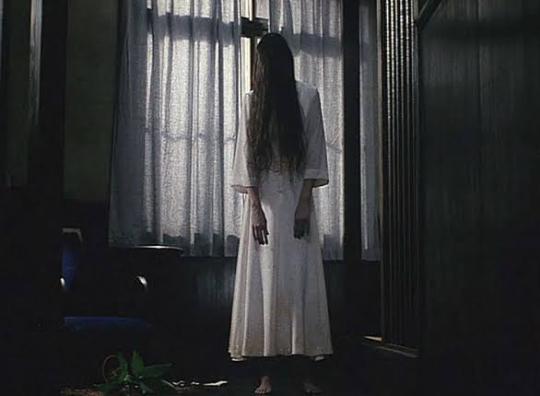
The most iconic Onryō and Japanese horror symbol of all. Sadako's story suffered retcoms during the Ring franchise. In the 1991s novel, she is a young intersex person (she identifies herself as female) who grew up in a toxic family, being explored because of her psychic powers. At 19s, she is raped by a doctor named Jotaro and throw alive inside of the well. In 1998s Ringu, she was a cruel sadistic child who murdered a journalist and ruined her mother's life. She was murdered by her step-father that wanted to save the world from her evil, but she became a vengeful ghost. In the 2000s Ringu 0, Sadako is portrayed as a victim, since she can't control her powers and is afraid of her biological dad, a sea demon. She was drugged and isolated by her step-father during her life, emotionally abused and explored in her adult life, collectively beaten after being exposed to an old scandal and lated 30 years to die inside of the well. In every version of the story, she uses her nensha and telepathic powers to record a videotape that murders their victims in seven days. As technology is her weapon, she crawls out of people's TV (except in the novel).
Kayako Saeki (佐伯 伽椰子)

Based in Oiwa's legend, Kayako Saeki was a lonely neglected girl that married a jeaously abusive husband, Takeo Saeki. She had a kid with him, Toshio. We have more details about their relantionship in the first 2000s movie Ju-On: The Curse, where Takeo abuses his wife and kid more than one month before the curse started. When Takeo discovered Kayako had feelings for her childhood friend, Kobayashi – who ironically was Toshio's teacher –, he broke her neck, murdered their black-cat, their young child and even killed Kobayashi's pregnant wife. Their suffering was so cruel that it started a deadly curse inside of the house, which killed Takeo, the teacher and curses everyone and anyone that enters it.
With all of these stories, and many other legends about monstrous female creatures and ghosts, we can notice that Japanese women always had a grudge against their opressive misogynistic society. Most of the horror Japanese movies portray women that were victimized by men and now are searching for revenge. If their society thinks their suffering and death is OK or justificable, then, they have no other choice than searching for their own justice.
Japanese society improved significantly during the years. Women now have voice, power, intelligence and place in the Japanese society. Divorces are permitted, they have laws against misogynistic violence, women can work and be solo mothers, majority of cultural and intelectual institutions are occuped by women. Japanese society was always impressive, intelligent and productive, but they still needed to be socially envolved. And it is working.

Social evolution surelly doesn't depend on movies or legends, but fictional works and culture does influence people for the good. It is because of humanity's fights, discussions and progress that our world, including Japan that once was one of the most sexists couples ever, that we are progressing and giving voice/space/respect to minories. We don't need female ghosts to avenge women or to "teach men", we need to look at our interior and our own mistakes, and learn how to fix them.
#japanese ghost#japanese movies#japanese society#Japan#🎌🇯🇵❤️#sadako yamamura#kayako saeki#kuchisake-onna#okiku#kuroneko#ringu#ju-on#ju-on: the grudge#oiwa#yotsuya kaidan#onryō#feminism#female ghosts#misoginy
351 notes
·
View notes
Video
youtube
youtube
[Being Japanese], documentary in 2 parts by Greg Lam from Life where I am from, tackling the subject of identity in Japanese so called “homogeneous” society (spoiler: it’s not as homogeneous as far right would like to believe). In Greg’s own words:
What makes a Japanese person Japanese? Is it the blood that runs through their veins? A parent they were born to? The country they grew up in? Is it how they look? How they act? How they speak? Their citizenship? A documentary exploring what it means to be Japanese.
Greg, father of 2 hâfu kids himself, went around interviewing several people about what they think about their identities and relation with Japan. Profils includes Ainu, “Okinawan”/Ryukyuan, but also Korean-descendants, nikkei/Japanese descendants, hâfu/biracial Japanese or kikokushijo/returnees. Second part of the documentary also covers refugees and naturalised/dual citizens (including a disabled person).
I can’t recommend you enough to watch this documentary! Be aware that some parts are difficult as they cover traumatic events/issues (racism, assault, etc) encountered by the interviewees. However, Greg Lam never falls prone to tearjerking, and many passages are amazingly covered!
#japan#video#documentary#Greg Lam#Life where I am from#identity#Japanese society#hafu#biracial#ainu#okinawa#ryuukyuu#Korean#Zainichi-Korean#nikkei#Japanese descendant#kikokushijo#refugee#dual citizen#naturalised citizen#disabled#cw: racism#cw:assault
416 notes
·
View notes
Photo

The adults sat around their radios and cried. The children gathered outside in the dusty road and whispered their bewilderment. We were most surprised and disappointed that the emperor had spoken in a human voice.
- Kenzaburō Ōe, A Portrait of the Postwar Generation
On On 15 Aug. 1945, Hirohito announced the unconditional surrender to the United States. The future Nobel literature prize winner, Kenzaburō Ōe, was only ten years old when he heard the emperor of Japan on the radio.
Throughout Japanese history, the emperor had been viewed as a demi-god, remote from the populace. That tradition was shattered on this day (Tokyo time) in 1945 when Emperor Hirohito made a 673-word radio broadcast accepting the terms of the July 26th Potsdam Declaration. His announcement marked the first time commoners in Japan, with a few exceptions, had heard the emperor’s voice.
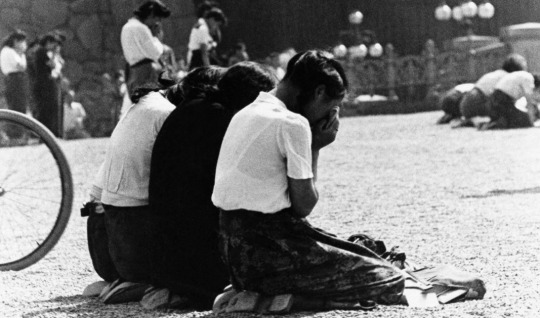
The declaration warned Japan that unless it accepted its terms of “unconditional surrender,” the nation would face “prompt and utter destruction.” The document was signed by President Harry S. Truman, British Prime Minister Churchill and Chiang Kai-shek, the Chinese Nationalist leader. It made no mention of Hirohito.
The Tokyo leadership, divided over how to proceed, dithered. One faction hoped the Soviet Union would broker a deal. (Instead, the Soviets declared war on Aug. 9, grabbing a share of the spoils.)
Truman responded by authorizing the dropping of an atomic bomb on Hiroshima on Aug. 6 and a second bomb on Nagasaki three days later. They devastated the two cities, killing an estimated 246,000 people in matters of seconds.
Hirohito (1901-89) began his broadcast by saying: “To our good and loyal subjects: After pondering deeply the general trends of the world and the actual conditions obtaining in our empire today, we have decided to effect a settlement of the present situation by resorting to an extraordinary measure. We have ordered our government to communicate to the governments of the United States, Great Britain, China and the Soviet Union that our empire accepts the provisions of their joint declaration.”

The emperor went on the say, falsely, that “we declared war on America and Britain out of our sincere desire to insure Japan’s self-preservation and the stabilisation of East Asia, it being far from our thought either to infringe upon the sovereignty of other nations or to embark upon territorial aggrandisement.
“But now the war has lasted for nearly four years. Despite the best that has been done by everyone - the gallant fighting of our military and naval forces, the diligence and assiduity of our servants of the state and the devoted service of our 100 million people - the war situation has developed not necessarily to Japan’s advantage, while the general trends of the world have all turned against her interest.
“Moreover, the enemy has begun to employ a new and most cruel bomb, the power of which to do damage is, indeed, incalculable, taking the toll of many innocent lives. Should we continue to fight, it would not only result in an ultimate collapse and obliteration of the Japanese nation, but also it would lead to the total extinction of human civilisation.”

Hirohito’s broadcast culminated in the signing of surrender documents on the foredeck of the battleship USS Missouri in Tokyo Bay on Sept. 2, 1945.
#kenzaburo oe#quote#literature#author#war#japan#japese#emperor hirohito#hirohito#second world war#japanese surrender#japanese society#history
101 notes
·
View notes
Photo
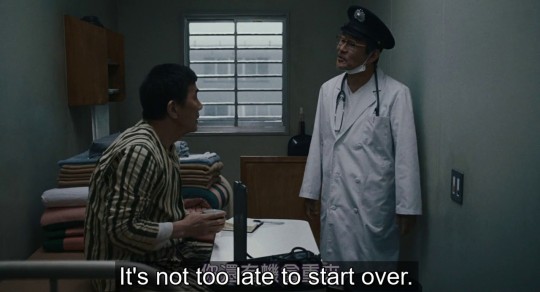
すばらしき世界 [Under the Open Sky] (Miwa Nishikawa - 2020)
#すばらしき世界#Under the Open Sky#Miwa Nishikawa#jail#Contemporary Japanese Cinema#Kōji Yakusho#Taiga Nakano#Yukiya Kitamura#Seiji Rokkaku#Hakuryu#yakuza#prison#Japanese people#Narumi Yasuda#Meiko Kaji#Ryûzô Saki#Subarashiki Sekai#Isao Hashizume#freedom#life#welfare#Masami Nagasawa#Japanese society#drama film#wisdom#friendship#friends#orphanage#detention#second chances
2 notes
·
View notes
Text
絆 (ki-zu-na) “bonds”

絆 can refer to any kind of "bond", but it usually refers to the "bonds" that structure human relationships.
Although the word "bond" sounds inflexible and unforgiving, in Japanese it usually has a positive nuance when used to describe human relationships.
Even if the nature of a human relationship leads to a reduction in one’s personal freedom, the "bonds" are still respected because they create structure and help people to find their place in society. (And hopefully the relationship will be caring and supportive).
In some ways the "bonds" themselves are seen as more important than the people they connect. An upside of this is that you don’t have to like your boss! Sure, you might have to do what s/he says… but your feelings on him/her as a person are irrelevant. Which can be strangely liberating.
#Japan#Japanese culture#Japanese art#Japanese Calligraphy#asian art#Asian calligraphy#japanese society#Japanese language#Japanese words#kanji#Japanese#書道
58 notes
·
View notes
Photo

(via Murakami’s Japan)
While enjoying Murakami’s literary works, I’ve often had the suspicion that his words weren’t reflecting the Japanese society or the Asian-ness that was before his eyes, but was rather an attempt by him to live the Japan that resided within his mind and dreams.
Nevertheless, this is perfectly alright, as it’s a manifestation of fiction. Moreover, it happens because Murakami is a global citizen, a wild soul, a free spirit, that transcends artificial borders and belongs to the human culture. Pica...
(Read full text on booksperience.org)
#books#reading#art#asia#asianness#fiction#haruki murakami#imagination#japan#japanese culture#japanese society#literature#modern art#pablo picasso#japanese literature#booksperience
0 notes
Text
youtube
Watch this, if you dare!
0 notes
Text
Living as Japanese 27: "Nominication"
Here’s one of prominent social communications in Japan.
That is “Nominication”.
This is a coined word of Japanese and English, and means “communication over drinking”.
I think Japan is a top-ranked country where working men and women go and drink after their work.
You can see a lot of people drink in Japanese pubs every night.
One of my friends was amazed and said before, “I cannot believe that almost every night they go and drink with their working/business mates. In my country, we go back to home after work and spend our time with our family…”
I understand it.
But, this is one of unique social manners of Japan.
I wrote most of Japanese people do not ask questions in a meeting, then where do they discuss?
Here in pubs.
They frankly discuss the topics over driking.
Thus, having dinner with driking is very essential for Japanese business men and women
If they do not join, they might miss the info and it might give them negative effects related to their work.
Thus, they often go to drink together.
Also this makes our communication better.
If you are not used to work with Japanese business men and women, let’s try "Nominication".
It works good.
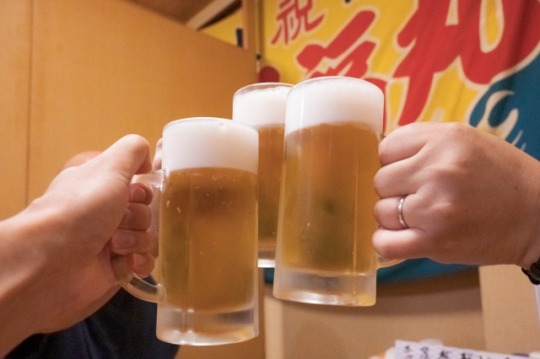
0 notes
Text

let her go
#homestuck#vriska serket#terezi pyrope#vriska#terezi#vrisrezi#mic_art#screencap redraw of that one utena scene woohoo#vrisrezi and utenanthy dont share many similarities but there are some interesting parallels that can be drawn#like theyre all characters who are devoted to the respective roles they think they have#utena needs to be a prince and vriska needs to be a hero#terezi needs to cast vriska as the villain so that she can be the one to bring her to justice while anthy#is resigned to her role as the rose bride and is cast as a witch by others (and herself in a way...) to justify her suffering#im too tired to put into words all the other shit rattlign around in my brain but something something vriska society violence princes utena#something interesting to note is that in the rgu stabbing scene utena is walking to the left while is hs vriskas walking to the right#which i think is mostly a cultural difference due to english being read left to right while japanese is read right to left#changing which direction is percieved as forward#which could be read further into but could also just be the natural flow of the scene or whateevr#idk i need to peruse ohtori.nu again i looooove reading utena essays
2K notes
·
View notes
Text
i read an otherwise very good analysis of Japan and Westernization that was capped off by the suggestion that Japanese society should be analyzed as a “culture of consumption”… that applies to literally every society in the world today dawg
#japanese society#consumption#westernization#japanese culture#consumerism#americanization#here’s a relevant Jim Gaffigan quote:#it’s all McDonald’s!#erryone from the most backward country hick to the most progressive queer person eats McDonald’s#McDonald’s here doesnt refer specifically to the fast food chain but just the derech eretz of consumption today#the thing is that consumption is everything for us#wait was Jim Gaffigan cancelled or some shit?
0 notes
Text
Seven Eleven versus Mitoshi Matsumoto
Nov 23rd is Japanese Labor Thanksgiving! 🦃 Let's learn about a recent labor struggle that blew up on Japanese media #twosecondstreet #seveneleven

View On WordPress
#convenience store#Japanese culture#Japanese labor issues#Japanese society#labor unions#living in Japan#Mitoshi Matsumoto#Seven Eleven#Seven Eleven controversy#Seven Eleven Japan#Two Second Street#working in Japan
0 notes
Text
Land of the Rising Cat
Book review:

Did you know that there is a cat island in Japan? What about the cat temples and festivals? The companies that make mini human furniture for cats? The cat celebrity that rejuvenated a train line? If any of the aforementioned sparks your interest, there are only more cat-related surprises in Land of the Rising Cat, where author Manami Okazaki depicts the bizarre world of Japan’s kitty craze with beautifully printed photos and enticing illustrations.
Japan may be the country that obsesses over our feline friends the most, where cats are abundant in households, art, and popular culture. Katsuhiro Miyamoto, professor emeritus at Kansai University, estimates that the feline industry of Japan was worth 2.3 trillion yen (~27.2 billion AUD) in 2015. Naturally, one may begin to wonder why Japan is so obsessed with cats, and what about cats could possibly generate such a crazy amount of money. Land of the Rising Cat provides an insight to both questions.
The book delves into every aspect of Japanese cat culture. From the history of cats in Japan, the origin of the cat boom, and traditional cat artisans to cats in popular culture, cat-themed shops and accommodations, and cats in modern art and design. Okazaki describes everything you might want to know about cats in Japan and surprises you with products of feline influence that you may have never imagined. It is not an exaggeration to describe this book as the encyclopaedia to cats in Japan.
The book also features interesting interviews of people associated with the aforementioned feline-inspired work. Okazaki asks the priests, artists, designers, museum curators, and company owners about why they are committed to their cat-centric work and their opinions on the cat influence in Japan. Since the Japanese cat craze is tightly intertwined with Japanese culture, while learning about the cat boom you will also gain a deeper appreciation for Japanese culture. If you are fascinated by the feline culture in Japan and wish to see some of it with your own eyes, do not fret as Okazawa has prepared a fantastically drawn map of destinations throughout Japan to visit and witness the feline frenzy in a logistically practical manner.
Shelf: 645.7 OKA
Land of the rising cat : Japan’s feline fascination.
by Manami Okazaki.
New York : Prestel Publishing, 2019.
ISBN: 9783791384948
174 pages : colour illustrations ; 24 cm.
Text in English
#cats#cats in art#photography of cats#new#review#review 2022 05#japanese culture#popular culture#japanese society#japanese customs#pets#fads
0 notes
Text
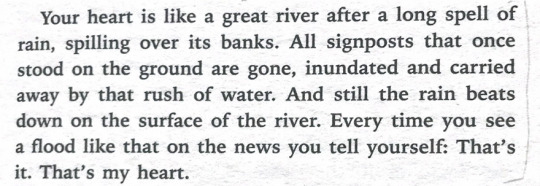
haruki murakami, kafka on the shore, p. 11
#hiyutekivigil#haruki murakami#kafka on the shore#japanese literature#literature#lit#quotes#words#books#academia#academia aesthetic#dark academia#light academia#chaotic academia#classic academia#dead poets society
251 notes
·
View notes
Text
"why couldn't shuro have just been honest about what he felt with laios and falin it's not that hard" are you. are you White
#dungeon meshi#shuro#toshiro nakamoto#look you can hate him for other things but this is very clearly a case of cultures (& personalities influenced by these cultures) clashing#shuro is japanese/east asian-coded and laios is european white boy#i am not japanese but i also come from a collectivistic society#pakikisama is a filipino value both prized and abhorred#it relies heavily on being able to read social cues and prior knowledge of societal norms#shuro being from a different country/culture is important to his character#his repressed nature is meant to contrast with laios' open one like that's the point#they both had similar upbringings but different coping mechanisms#shuro explicitly admits that he's jealous of laios being able to live life sincerely#anyway the point is they were operating on different expectations entirely and neither had healthy enough communication skills#to hash things out before they got too bad#re his attraction to falin i personally believe he unfortunately mpdg-ed her#she represented something new & different. a fresh drink of water for his parched repressed self#alas not meant to be#i'll be honest the way ryoko kui handles both fantasy & regular racism in dm is more miss than hit for me#i don't doubt that a lot of the shuro hate is based off of marcille's pov of him#marcille famously racist 😭#characters' racist views don't often get (too) challenged#practically everyone is casually racist at some point#anyway. again if you're gonna hate shuro at least hate him for being complicit in human trafficking & slavery#he couldn't help falling for the wrong woman goddamn 😭#calemonsito notes
196 notes
·
View notes